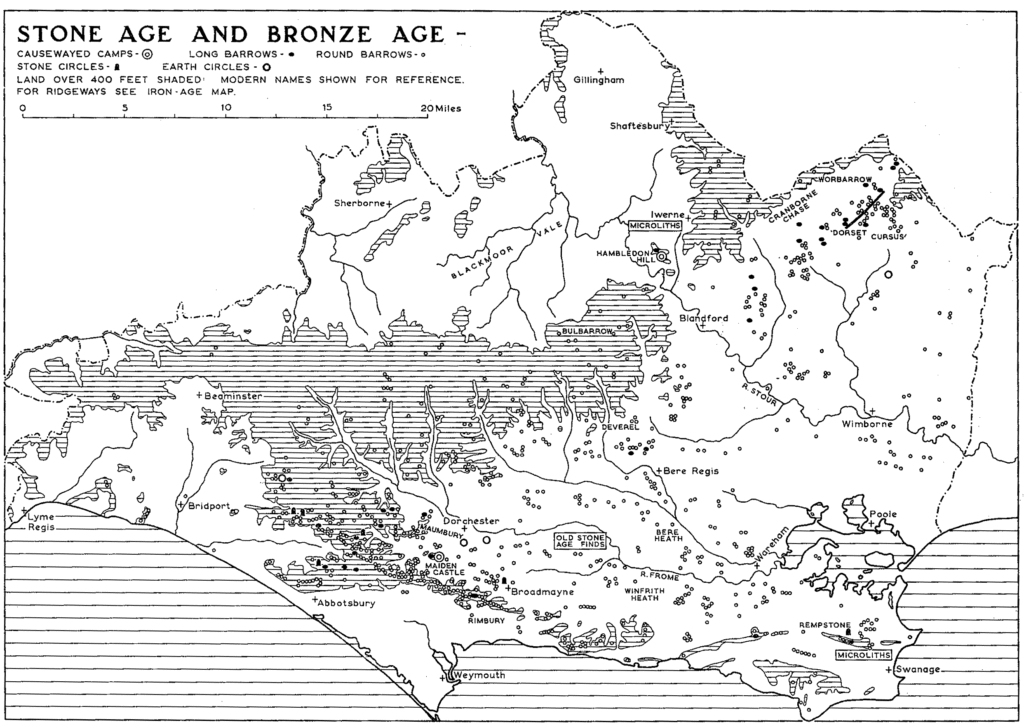
A History of Dorset
Stone Age and Bronze Age
The earliest traces of Man in Dorset are flint tools dating from the warmer periods between the Ice Ages, discovered in the gravels by the River Frome near Moreton and now preserved in Dorchester Museum. Others have been found further down the river at Corfe Mullen, and a single hand-axe has come from similar gravels at Sherborne.
The wet forested period known as ‘Mesolithic’ or Middle Stone Age, When the ice had finally retreated and men were adjusting themselves to live by hunting smaller animals and by fishing, is represented by microliths from Purbeck and Iwerne Minster. Microliths are small sharp flakes of flint, used to tip arrows, barb harpoons, or give a cutting edge to other tools or Weapons of flint or bone. Nothing of the Old or Middle Stone Ages now shows on the surface, since men lived entirely by hunting, fishing, or gathering wild fruits and seeds, and they never settled long in one spot. Nor were there many of them.

With the arrival of the first Neolithic or New Stone Age settlers about 2500 BC, Dorset comes well into the picture. These people kept domesticated animals, and grew wheat and a little barley in small plots cultivated With digging—sticks or hoes. They settled on the chalk uplands of Wessex, Wherever there was no clay topsoil to encourage forest, and cleared the scrub to make pasture and cultivation plots. They also built earthworks known as ’causewayed camps’, of which Dorset had two (at Maiden Castle and Hambledon Hill) of the dozen so far traced. These took the form of circular earth banks and ditches, with at least two separate rings, frequently broken by the ’causeways’ from which they are named. With their many entrances they can hardly have been defences, and they were probably cattle corrals used for rounding up the herds in late summer for the annual killing. They were not villages, since they generally contain no traces of huts.
New Stone Age people also buried their more important dead in long barrows, long mounds which sometimes had a stone burial chamber inside. These contained several burials, and were probably the ‘family vaults’ of the Chieftains. In Dorset there are two main groups, both on the open chalk. One lies on the ridge between Long Bredy and Dorchester, and the other. in the north—east of the county near the Wiltshire border. With the two causewayed camps, they probably mark the areas of densest Neolithic settlement.
One long barrow, at Maiden Castle, was a third of a mile in length, and contained the bones of a man whose limbs and brain had been ceremonially eaten — no doubt in the hope of acquiring his strength and wisdom. Some have doubted whether this was simply a barrow, and have compared it with the peculiar earthwork called the ‘Dorset Cursus’ in the north-east barrow-group. This consists of two parallel banks running for over six miles, squared off at each end to enclose a strip about ninety yards wide. It may have been used for religious processions.
Being herders and cultivators, the Neolithic people were much concerned with magical rites to ensure the fertility of crops and stock; and in later times they made earthen circles (with the ditch inside the bank) for this purpose. The most famous is Maumbury Rings at Dorchester, which began in this fashion, was later used as the amphitheatre of the Roman town, and finally served as a redoubt during the Civil War.
About 1900 BC arrived the first bronze—using people, known from the pots buried with them as ‘Beaker Folk’, who settled in Dorset and drove out or enslaved the previous inhabitants. Traces of them are found both at Maiden Castle and Hambledon Hill. Their farming was similar to that of their predecessors, except that they grew far more barley than wheat, and kept sheep (from whose wool they wove cloth). For centuries bronze remained scarce, and they still used flint.
They buried their important dead in round barrows (like all Bronze Age people) and put up stone circles for religious purposes in the south of the county. Later on, Wessex was ruled by powerful chiefs who traded with the Baltic and Mediterranean lands and about 1500 BC completed Stonehenge. One of these was buried in Clandon Barrow near Maiden Castle, with a gold—studded mace and other treasures of gold and amber.
The Bronze Age climate was drier than the Neolithic, and part of the chalk uplands became too dry to be habitable. Instead there was for the first time considerable settlement on the sandy heaths nearer the rivers. This is shown on the map by the spread of round barrows into areas where long barrows are never found.
The Late Bronze Age, from about 750 BC, saw the arrival of plough-using Celts who introduced settled farming, using fair-sized fields which can still be traced, and making cattle—enclosures. They are now known as the ‘Deverel-Rimbury’ people from two of their Dorset burial sites – a barrow at Deverel and a cemetery near Weymouth.
The north and west of Dorset have few remains of this period. The clay vales, and the clay-covered hills, were forested and therefore unattractive to people who preferred the more easily cleared chalk and heath.
